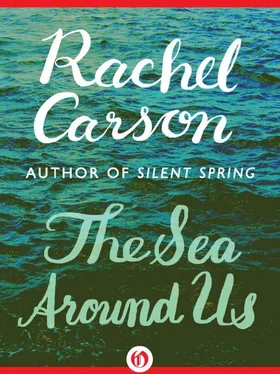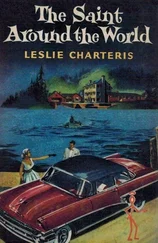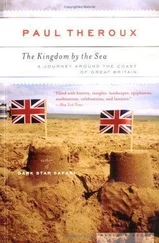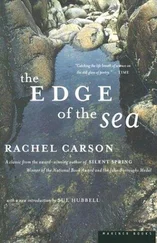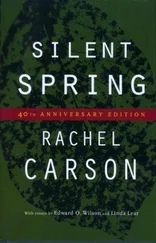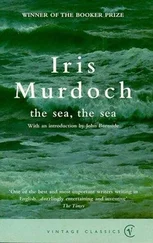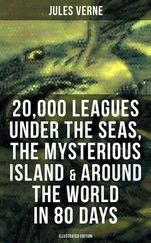The plants have undisputed sway in the sea for only a short time. Almost at once their own burst of multiplication is matched by a similar increase in the small animals of the plankton. It is the spawning time of the copepod and the glassworm, the pelagic shrimp and the winged snail. Hungry swarms of these little beasts of the plankton roam through the waters, feeding on the abundant plants and themselves falling prey to larger creatures. Now in the spring the surface waters become a vast nursery. From the hills and valleys of the continent’s edge lying far below, and from the scattered shoals and banks, the eggs or young of many of the bottom animals rise to the surface of the sea. Even those which, in their maturity, will sink down to a sedentary life on the bottom, spend the first weeks of life as freely swimming hunters of the plankton. So as spring progresses new batches of larvae rise into the surface each day, the young of fishes and crabs and mussels and tube worms, mingling for a time with the regular members of the plankton.
Under the steady and voracious grazing, the grasslands of the surface are soon depleted. The diatoms become more and more scarce, and with them the other simple plants. Still there are brief explosions of one or another form, when in a sudden orgy of cell division it comes to claim whole areas of the sea for its own. So, for a time each spring, the waters may become blotched with brown, jellylike masses, and the fishermen’s nets come up dripping a brown slime and containing no fish, for the herring have turned away from these waters as though in loathing of the viscid, foul-smelling algae. But in less time than passes between the full moon and the new, the spring flowering of Phaeocystis is past and the waters have cleared again.
In the spring the sea is filled with migrating fishes, some of them bound for the mouths of great rivers, which they will ascend to deposit their spawn. Such are the spring-run chinooks coming in from the deep Pacific feeding grounds to breast the rolling flood of the Columbia, the shad moving into the Chesapeake and the Hudson and the Connecticut, the alewives seeking a hundred coastal streams of New England, the salmon feeling their way to the Penobscot and the Kennebec. For months or years these fish have known only the vast spaces of the ocean. Now the spring sea and the maturing of their own bodies lead them back to the rivers of their birth.
Other mysterious comings and goings are linked with the advance of the year. Capelin gather in the deep, cold water of the Barents Sea, their shoals followed and preyed upon by flocks of auks, fulmars, and kittiwakes. Cod approach the banks of Lofoten, and gather off the shores of Ireland. Birds whose winter feeding territory may have encompassed the whole Atlantic or the whole Pacific converge upon some small island, the entire breeding population arriving within the space of a few days. Whales suddenly appear off the slopes of the coastal banks where the swarms of shrimplike krill are spawning, the whales having come from no one knows where, by no one knows what route.
With the subsiding of the diatoms and the completed spawning of many of the plankton animals and most of the fish, life in the surface waters slackens to the slower pace of midsummer. Along the meeting places of the currents the pale moon jelly Aurelia gathers in thousands, forming sinuous lines or windrows across miles of sea, and the birds see their pale forms shimmering deep down in the green water. By midsummer the large red jellyfish Cyanea may have grown from the size of a thimble to that of an umbrella. The great jellyfish moves through the sea with rhythmic pulsations, trailing long tentacles and as likely as not shepherding a little group of young cod or haddock, which find shelter under its bell and travel with it.
A hard, brilliant, coruscating phosphorescence often illuminates the summer sea. In waters where the protozoa Noctiluca is abundant it is the chief source of this summer luminescence, causing fishes, squids, or dolphins to fill the water with racing flames and to clothe themselves in a ghostly radiance. Or again the summer sea may glitter with a thousand thousand moving pinpricks of light, like an immense swarm of fireflies moving through a dark wood. Such an effect is produced by a shoal of the brilliantly phosphorescent shrimp Meganyctiphanes, a creature of cold and darkness and of the places where icy water rolls upward from the depths and bubbles with white ripplings at the surface.
Out over the plankton meadows of the North Atlantic the dry twitter of the phalaropes, small brown birds, wheeling and turning, dipping and rising, is heard for the first time since early spring. The phalaropes have nested on the arctic tundras, reared their young, and now the first of them are returning to the sea. Most of them will continue south over the open water far from land, crossing the equator into the South Atlantic. Here they will follow where the great whales lead, for where the whales are, there also are the swarms of plankton on which these strange little birds grow fat.
As the fall advances, there are other movements, some in the surface, some hidden in the green depths, that betoken the end of summer. In the fog-covered waters of Bering Sea, down through the treacherous passes between the islands of the Aleutian chain and southward into the open Pacific, the herds of fur seals are moving. Left behind are two small islands, treeless bits of volcanic soil thrust up into the waters of Bering Sea. The islands are silent now, but for the several months of summer they resounded with the roar of millions of seals come ashore to bear and rear their young—all the fur seals of the eastern Pacific crowded into a few square miles of bare rock and crumbling soil. Now once more the seals turn south, to roam down along the sheer underwater cliffs of the continent’s edge, where the rocky foundations fall away steeply into the deep sea. Here, in a blackness more absolute than that of arctic winter, the seals will find rich feeding as they swim down to prey on the fishes of this region of darkness.
Autumn comes to the sea with a fresh blaze of phosphorescence, when every wave crest is aflame. Here and there the whole surface may glow with sheets of cold fire, while below schools of fish pour through the water like molten metal. Often the autumnal phosphorescence is caused by a fall flowering of the dinoflagellates, multiplying furiously in a short-lived repetition of their vernal blooming.
Sometimes the meaning of the glowing water is ominous. Off the Pacific coast of North America, it may mean that the sea is filled with the dinoflagellate Gonyaulax, a minute plant that contains a poison of strange and terrible virulence. About four days after Gonyaulax comes to dominate the coastal plankton, some of the fishes and shellfish in the vicinity become toxic. This is because, in their normal feeding, they have strained the poisonous plankton out of the water. Mussels accumulate the Gonyaulax toxins in their livers, and the toxins react on the human nervous system with an effect similar to that of strychnine. Because of these facts, it is generally understood along the Pacific coast that it is unwise to eat shellfish taken from coasts exposed to the open sea when Gonyaulax may be abundant, in summer or early fall. For generations before the white men came, the Indians knew this. As soon as the red streaks appeared in the sea and the waves began to flicker at night with the mysterious blue-green fires, the tribal leaders forbade the taking of mussels until these warning signals should have passed. They even set guards at intervals along the beaches to warn inlanders who might come down for shellfish and be unable to read the language of the sea.
But usually the blaze and glitter of the sea, whatever its meaning for those who produce it, implies no menace to man. Seen from the deck of a vessel in open ocean, a tiny, man-made observation point in the vast world of sea and sky, it has an eerie and unearthly quality. Man, in his vanity, subconsciously attributes a human origin to any light not of moon or stars or sun. Lights on the shore, lights moving over the water, mean lights kindled and controlled by other men, serving purposes understandable to the human mind. Yet here are lights that flash and fade away, lights that come and go for reasons meaningless to man, lights that have been doing this very thing over the eons of time in which there were no men to stir in vague disquiet.
Читать дальше
